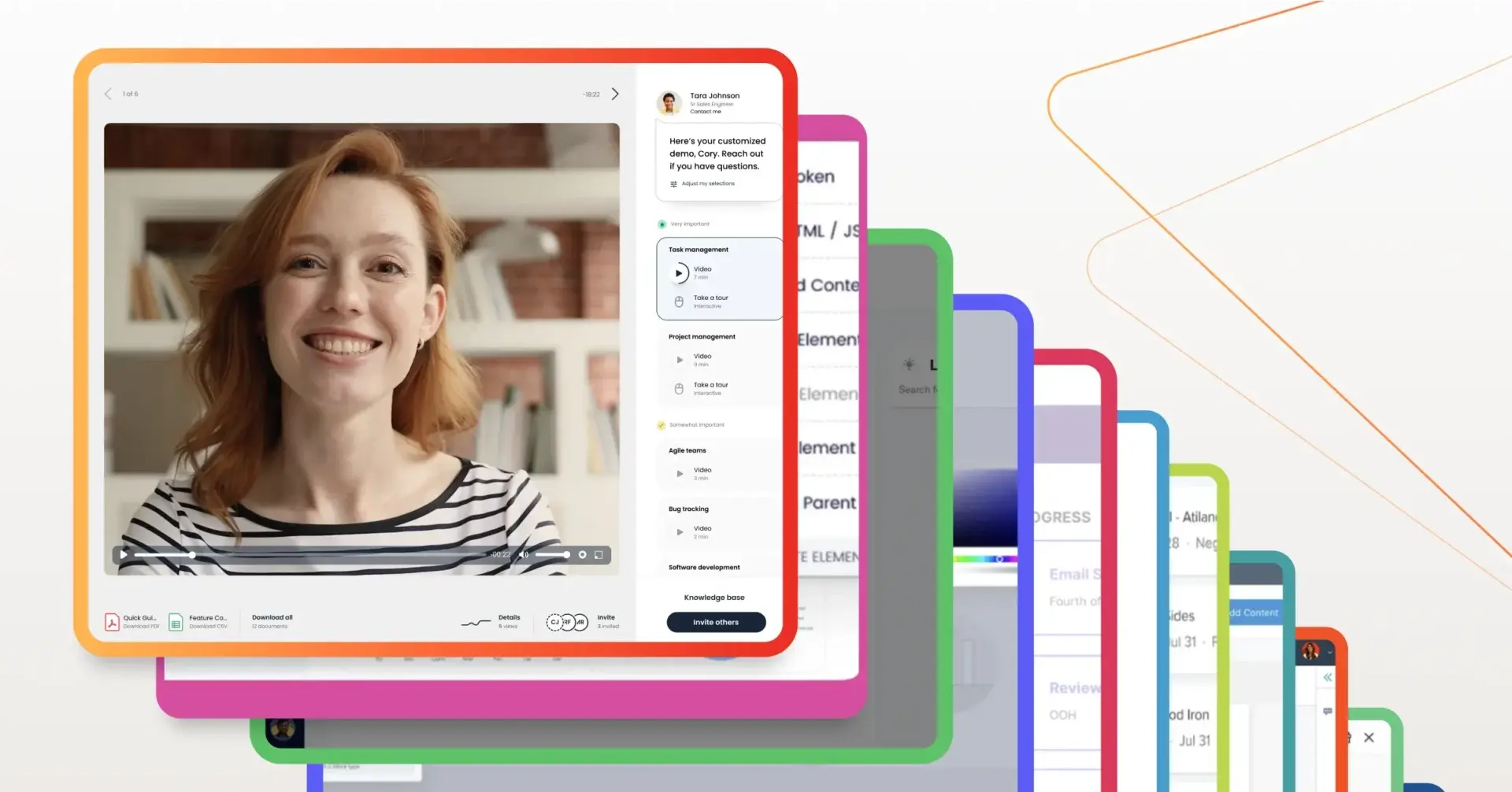Close more deals with
Demo Automation.
Watch a Demo
Your customers want to see and use your product before they buy it. They need to understand how features work, what value they’ll get, and whether the product fits their needs. Every click, every interaction, and every moment spent with your product shapes their decision to buy—or to leave.
Effective product experience management (PXM) is all about creating a frictionless, engaging buyer journey—from delivering interactive product demos to providing instant answers and making the purchase process seamless. These actions can enhance deal sizes and win rates since personalized, optimized experiences yield a 10% to 15% increase in conversions. On the other hand, ineffective product experiences cost you deals and customers. When buyers can’t figure out how to use core features or get stuck during onboarding, they’ll move on to competitors.
The solution? Product experience platforms. This software gives revenue teams control over how users interact with their product. From guided product tours to usage analytics, PX platforms help teams create experiences that convert buyers and retain customers. Let’s talk about what product experience means today and some of the best tools to help you improve yours.
Introduction to Product Experience (PX)
Product experience starts the very moment a prospect first engages with your product and continues as they explore, evaluate, decide to purchase, become a dedicated user, and transform into your champion. But in a world where buying has shifted almost entirely online, buyers are losing sensory input compared to traditional, in-person experiences. They can’t physically touch a product, walk into a store, or interact with a salesperson face-to-face. That means the limited senses available in digital buying experiences become even more critical—they have to do more work to create trust, engagement, and confidence in the decision-making process.
While we can’t replicate all of that online, we can leverage the senses that are available to us in the digital world—sight, sound, and a kind of digital “feel”—to create a similar sense of trust and connection. Think of product experience as a map of how buyers interact with your product to solve problems and reach their goals. A seamless, engaging product experience doesn’t just inform. It shows the value of your solution first-hand. It builds confidence, accelerates decision-making, and enables your champions to sell internally.
A full-funnel product experience focuses on four key actions that can engage the three senses that buyers use to buy digital things: sight, sound, and feel.
- Watching: Watching lets buyers use one of the core senses they use for digital purchases: sight. When a potential customer watches engaging content focused on your product, like a preconfigured demo created with demo automation software, they receive an in-depth, personalized overview that lets them get their first taste of just what you offer.
- Trying: Trying enables your potential buyers to begin interacting with your product. This step goes beyond sight, adding sound and feel. By using tools like engaging product tours, your buyers get a guided tour of your platform, letting them learn about your product, specifically the features that they need the most, in a hands-on way.
- Exploring: Exploring lets your buyers wander through your product on their own. Now is the time for them to fully unpack the diverse capabilities of your solution through tools like product simulations.
- Tracking: Tracking is another vital part of product experience management. Your sellers need to understand what’s working and what isn’t working with their product experience to be able to improve it and better address buyer needs. Think of product experience as a cycle. Proper ranking, such as through Consensus’ Demolytics, enables the cycle to start again, better than before.


Gather organic stakeholder insights with Consensus.
Product Experience vs. User Experience
User experience (UX) makes individual features work smoothly, while product experience (PX) ensures that those features deliver actual value. While UX might perfect button placement and navigation paths, PX focuses more on helping users achieve measurable outcomes. You might have a beautiful interface, but PX determines whether buyers think those well-designed features will improve their work.
Both matter for different reasons—user experience handles the details, but product experience drives results.
Pre-Purchase Product Experience vs Post-Purchase Product Experience
A great product experience doesn’t start at onboarding—it begins the moment a prospect first engages with your product. Pre-purchase, the goal is to build confidence and accelerate decision-making. Buyers want an interactive, personalized experience that helps them see the value of your solution before committing. Scalable, self-guided demos let them explore relevant use cases, while instant access to information keeps momentum high. Since most B2B deals involve multiple stakeholders, a frictionless, shareable experience ensures everyone is aligned—reducing objections and shortening sales cycles.
Post-purchase, the focus shifts from persuasion to adoption and advocacy. Customers expect a seamless onboarding experience that delivers immediate value. Interactive product education—like product tours and self-service learning tools—keeps users engaged and drives retention. The easier it is for customers to integrate your product into their workflow, the more likely they are to expand usage and champion your solution. A strong end-to-end product experience doesn’t just win deals—it creates long-term advocates who fuel revenue growth.
Why a Great Product Experience is Important
A poor buying experience can cost you deals, delay sales cycles, and even lead to an increase in customer churn. When buyers struggle to understand how their product solves their challenges and addresses their needs, they lose confidence and trust in your product and start looking elsewhere.
But the good news is that when your product experience is seamless, intuitive, and value-driven, everything changes, both before and after purchase. Here’s why investing in product experience pays off across your entire customer lifecycle.
Shortens Sales Cycles
Buyers hate waiting. How much do they hate waiting?
About 75% of consumers say that the biggest determiner of a positive experience with a company is fast response times.
They don’t want to sit around waiting for you to contact them after they reach out to you, playing back-and-forth phone tag, before they can learn about your solution. They want to evaluate your product now—not after three discovery calls and a week of calendar coordination.
A strong product experience lets prospects explore your solution immediately through interactive demos and self-guided tours. They’ll see exactly how your features solve their problems, leading to faster, more confident buying decisions that ultimately shorten your sales cycle.
Empowers Buyers
Your buyers want control over their purchasing process now more than ever, with nearly 100% of buyers saying that they want self-service tools during the buying journey. They’re tired of sitting through generic presentations that don’t address their specific needs. When you provide custom, on-demand product demonstrations, buyers can focus on the features that matter most to them.
When you put buyers in the driver’s seat, you’re giving your customers better buyer enablement. Buyer enablement is all about giving your buyers the tools to essentially not only sell themselves but also sell your product to internal stakeholders. Helping buyers self-educate means they’ll come to sales conversations better informed and ready to discuss implementation details rather than basic functionality. Empowered buyers make decisions faster because they’ve already validated your solution’s fit.
Increases Conversions
Clear product experiences drive conversions at every stage through personalized, optimized touchpoints.
In fact 80% of consumers say that they are more likely to buy from a brand that offers a customized product experience.
Pre-purchase, prospects convert more often when they can easily see how your solution fits their workflow, reflecting how a strong product experience enhances engagement. Customers come to calls with a deeper understanding of your solution and how it solves their problems, ready to talk specifics sooner. You’ll get more engagement while gaining the insights you need about your customers.
Post-purchase, new users convert to power users faster when they understand how to achieve quick wins. The math is simple: When users grasp your product’s value quickly, they’re more likely to buy, upgrade, and expand their usage.
Improves Retention
Long-term success depends on delivering continuous value—not just at the point of sale, but throughout the entire customer lifecycle. From day one, buyers need to understand not only why your solution is right for them but also how to leverage key features for their specific use case. When customers feel confident in their ability to succeed with your product, they’re more likely to stick around, leading to higher retention rates and more expansion opportunities. A well-managed product experience turns satisfied users into power users, opening the door for upsells, cross-sells, and deeper adoption across teams and departments.
While 80% of consumers will buy from brands with personalized product experiences, more than 60% say that they will stop buying from a brand if their experience stops being personalized and optimized for them. That means product experience isn’t just a pre-sale necessity—it’s a long-term growth strategy. Personalization and optimization must continue well beyond the initial purchase to keep customers engaged and invested. Companies that actively nurture post-purchase experiences don’t just retain customers; they create advocates who drive revenue through referrals, expansion, and upsell opportunities.
What Makes an Unforgettable Product Experience
Product experiences need three key elements to succeed: personalization, self-service, and ease of use. When you nail these components, buyers make decisions faster and stick with your product longer. Let’s look at how each element drives success.
Buyer Personalization
Your buyers want content that speaks directly to their problems—not generic feature lists. Personalized experiences convert because they show buyers exactly how your product solves their specific challenges. More than 75% of consumers say that they are more likely to buy from, recommend, and repurchase from brands that offer personalized experiences.
Using intent data and engagement signals helps you deliver the right features and use cases at the right time. Consensus offers the most in-depth analytics of any product experience solution through Demolytics. You can view stakeholder insights—including demos sent, organic stakeholders discovered, discovery rate, views, view rate, features selected, and docs downloaded—for any recipient of your product demo.
Self-service Opportunities
Sales reps shouldn’t be gatekeepers to your product information. Modern buyers expect immediate access to demos, documentation, and trial environments—with 97% of buyers saying that they want to have all their buying research and resources in one easy-to-access place.
On-demand product tours and interactive product demos let prospects explore features at their own pace. When buyers can freely investigate your product, they’ll move through their evaluation process faster and come to sales conversations better informed.
Ease of Use
Simple products win deals, while complicated products with a lack of usability cost businesses 35% of potential sales. Clear navigation paths and intuitive interfaces keep users focused on achieving their goals instead of learning your system. A straightforward product experience—from first login to advanced feature adoption—builds user confidence and speeds up implementation. Remember: Every extra click or confusing workflow risks losing a potential customer to a competitor with a simpler solution.
Product Experience Platform Features
A true product experience platform should enable all revenue teams to strengthen the whole of a product experience, from the first interaction to long after they transition to a power user. The best product experience platforms utilize the below features to let buyers watch, explore, and try your product—as well as measure results to continuously optimize the buying and customer experience.
Product Tour Software

Consensus product tour software
Product experience platforms should include product tours that guide users through your core features step-by-step. Users learn exactly where to click and what actions drive results—right inside your product interface. With product tour software, buyers get to explore at their own pace through a guided tour without your seller needing to actually do the guiding.
Interactive Demo Software

Consensus automated demo software
Interactive demo software lets buyers try your product before purchasing. Sales teams send these demos to prospects who want hands-on experience with specific features. Champions share demos with their colleagues, spreading product knowledge throughout the buying group. This product-led growth hybrid with interactive product demos leads to faster decisions based on real product interactions, not just screenshots or videos.
Product Simulation Environments

Consensus product simulation platform
Product simulations create safe spaces for learning and testing. Users practice in environments that mirror your actual product but without affecting live data. Sales engineers use simulations to prove technical capabilities during evaluations, and customer success teams leverage them for training programs. Plus, make changes quickly with the use of AI to edit fields and branding across simulations (at scale).
When users understand how features work in practice, they make confident decisions about implementing your solution/product.
Create an AI-Driven Demo Experience
Building a great product experience isn’t random—you need the right platform. And here’s what makes product experience platforms different: They’re built for buyers, not sellers. Your prospects want to explore products their way, at their pace, focusing on features that matter to them. When you give buyers control over the product experience, they make decisions faster and stay customers longer.
Looking for a way to win the buyer’s demands at every stage of their journey? Consider exploring Consensus, where you can:
- Watch: Engaging demos and video walkthroughs let buyers visualize the product in action, building excitement and clarity.
- Try: Hands-on product tours and interactive experiences allow buyers to test real use cases, reinforcing the product’s value.
- Explore: Deeper dives into features and capabilities let buyers self-educate and uncover the details that matter most to them.
- Track: Every interaction generates data, helping both buyers and sellers make faster, more informed decisions.
With Consensus, you can empower your buyers to explore, engage, and decide—all on their terms. With its automated demos, dynamic product tours, and simulations, Consensus’ AI-powered demo platform moves us beyond traditional demos, empowering companies to engage buyers through immersive, interactive experiences at every touchpoint.
Close more deals with Demo Automation
Need to showcase your product, accelerate buying decisions, and ensure customers see value before they purchase? Choose a product experience platform. A strong PX strategy bridges the gap between interest and adoption, turning prospects into confident buyers and customers into long-term advocates.
Your goals determine the right platform. Sales teams need demo automation to close deals faster. Customer success teams want robust onboarding tools. Product teams require usage analytics. Look for platforms that solve your specific challenges—whether shortening sales cycles or improving customer retention.
Consensus is an AI-powered demo platform that gives buyers the hands-on experience they crave and GTM teams the tools to close deals faster. From on-demand demos to interactive tours and simulations, Consensus makes buying simple.






